The Microsoft Surface Go LTE Review: Unmatched Mobility
by Brett Howse on January 17, 2019 8:00 AM ESTBattery Life
The Surface Go offers just a 27 Wh battery capacity, which is about half the size of a typical Ultrabook released in the last year. It’s also 40% smaller than the battery offered in the Surface Pro 6 which is the longest life Pro released yet. On the plus side, the smaller display has a lower pixel density, which should help, and the processor doesn’t offer any Turbo modes which would move the power draw of the CPU higher.
As with all of our battery testing, the display is set to 200 nits brightness, to provide an even playing field for all devices. We run several different tests of varying intensity with our 2016 Web test being the most demanding.
2013 Light Web

Our lightest test is our oldest, and the Surface Go isn’t off to a great start. At under eight hours on this test, the battery life is much less than a current generation Ultrabook, and well back of the latest model Surface Pro as well. A couple of years ago, this would have been reasonable battery life. In fact, the Surface Go almost matches the Surface Pro 3 in terms of runtime on this test, but the goal posts have definitely moved.
2016 Web
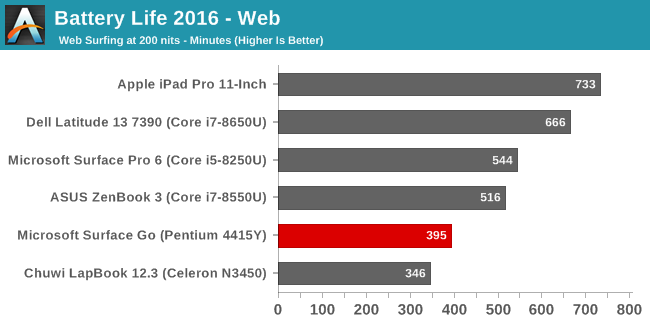
As with the previous test, the Surface Go struggles to keep up to the latest devices in this test as well. The Surface Pro 6 with a Core i5 offers 2.5 hours more battery life in this more demanding workload, which isn’t an insignificant amount of time. The tiny battery capacity hampers the Surface Go significantly here compared to other devices we’ve tested.
Movie Playback
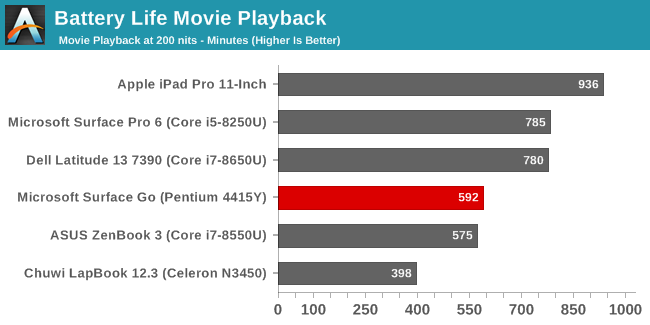
Movie playback is generally one of the best-case scenarios for modern devices since the media playback can be offloaded to the video decode unit, allowing the rest of the processor to go to sleep for much of the time. The Surface Go is still shy of the impressive results seen in the latest Surface Pro, but does get awfully near the 10-hour mark that Microsoft advertises for this device.
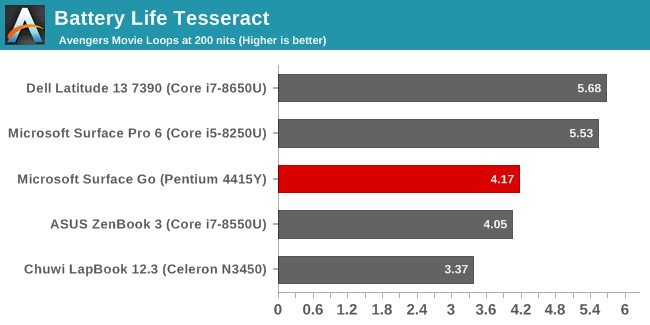
In terms of how many movies can you watch before the device runs out of juice, the Surface Go is pretty stout in this regard, with well over four runnings of The Avengers worth of battery life.
Normalized Results
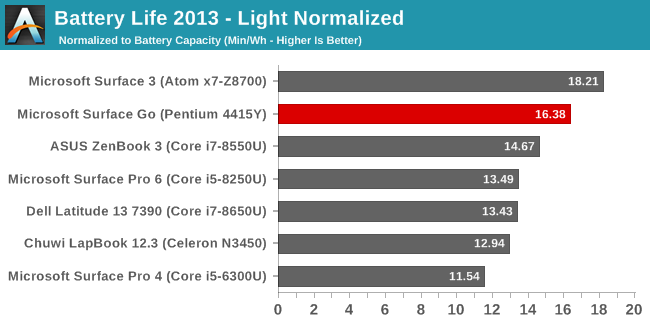
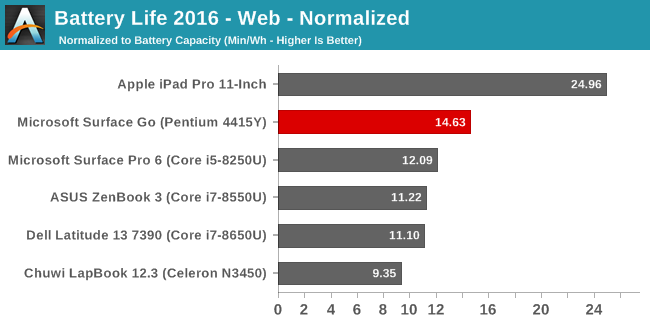
By removing the battery capacity from the equation, we can see how many minutes a device can last per Watt-Hour capacity of the battery. The Surface Go, mostly thanks to the display, does quite well in terms of efficiency. Put another way, on our 2016 Web test, the Surface Go averages 4.1 Watts of power draw with the display at 200 nits, and a Surface Pro 6 draws just a hair under 5 Watts during the same workload. So really, the less than amazing battery life really just comes down to not being able to fit more capacity in the Surface Go. The device is one of the most efficient we’ve tested.
Charge Time
The previous small form factor convertible tablet from Microsoft was the Surface 3, and it took a very long time to charge. Microsoft had outfitted it with a Micro USB port for charging, and then shipped it with just a 13 Watt AC adapter. It seems the company has learned its lesson there, and the Surface Go now offers the same Surface Connect port as the rest of the Surface lineup. It also ships with a 24 Watt adapter.
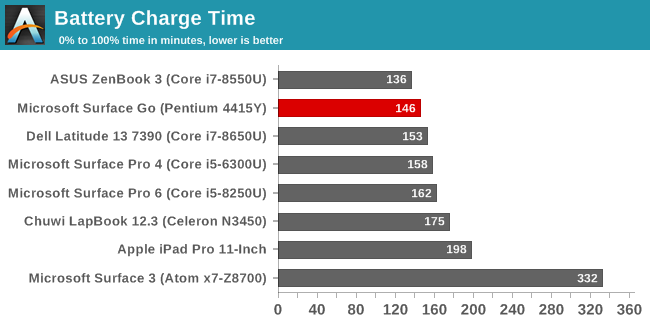
The result is a much better charge time than the Surface 3, and thanks to the smaller capacity battery, better than the Pro as well.
In addition, the Surface Go offers a USB-C port which will also do charging. This is a huge benefit for portable device such as this, since it would let you leave the main charger at home or work, and then use the same charger you use for your phone to top up the Surface Go. Microsoft seems to have an animosity towards USB-C, but this is the perfect device for them to offer it on.










79 Comments
View All Comments
TheinsanegamerN - Thursday, January 17, 2019 - link
Check out the ifixit teardown:https://www.ifixit.com/Teardown/Microsoft+Surface+...
The batteries make up less then half the interior volume, Compared to something like 80-90% for the ipad 6
https://www.ifixit.com/Teardown/iPad+6+Teardown/10...
It appears that not only is the chip much larger, butthe needs for a laptop style heatpipe cooling system eats up a TON of room, not to mention the PCB itself just seems far too large for the minimal components and ports. Perhaps MS's design efficiency leaves a LOT to be desired?
Either way, this is why windows on ARM is so exciting, and why I wish it was a lot further along. It seems ARM packaging is just way more efficient, allowing for far larger batteries. Combined with ARM's greater efficiencies, and x86 tablets like the go wind up with pathetic battery life numbers.
HStewart - Saturday, January 19, 2019 - link
I have never really cared about IFixIt's repair scores - I have had a Surface Pro 1 - since the beginning and it never need repair - only thing I can say able Apple iPad's and iPhone - after a couple of years there battery died.I think MS did a good job on this Surface GO.
TheinsanegamerN - Saturday, January 19, 2019 - link
I'm not referring to the scores. Look at the pictures, at the sheer amount of room in the Go VS the ipad.I cant see how having such poor battery life can be considered good. The OG surface pro had around the same usable life with a more power hungry chip and a compromised battery size.
dontlistentome - Friday, January 18, 2019 - link
Have one of these - 8GB/256GB/LTE/W10pro (and an SP4, Thinkpad X1 Carbon 5 and a Dell 7370).It's fine - it runs all the business apps I need (including some local database work, Python etc). Not perfect but feels much snappier in use that the Surface 3. Happy to take it when I travel knowing I can (bearably) run all I need to do work should the need arise. My 7370 also has LTE and is small, but this is a lot smaller/lighter - to the extent I can dump it in the wife's bag if we're out for the evening, something I never could with the dell.
Is it perfect? No, the Dell is also fanless but manages to cram in a m7 that turbos to 3.5GHz, something I guess I miss when a few processes are busy right after bootup.
As a pointer to the future, I'm happy - a few years from now when the performance distinction will be more based on core count, a Go2 or Go3 with a two core 10th gen fanless chip and decent RAM/SSD combo (which this already has for what most people need). Suspect when I do buy a Go3 though, it'll be Qualcomm inside, not intel.
HStewart - Saturday, January 19, 2019 - link
I doubt the GO3 will have a Qualcomm, by that time Intel will Perfect Sunny Cove - with more power than and battery life than Qualcomm.It is very interesting to me that Qualcomm got Microsoft to create Windows for ARM ( or can we say Windows for Qualcomm ) and yet Microsoft has release single product with it. It seams to me Microsoft does not trust it own OS. They would know better.
KPOM - Sunday, January 20, 2019 - link
It will be interesting if and when Apple either converts the 12” MacBook to the Ax series (A14X is my guess) and/or opens up iOS for iPad. I think ARM has a lot of capabilities and Microsoft is equally aware of them and could optimize Windows for ARM, at least for new applications. However, they are wedded to a lot of legacy x86 code and ARM hasn’t proven very adept at running Win32.Evil Mr M - Saturday, February 2, 2019 - link
FWIW, Costco members in the US can get a Surface Go bundle with 4GB/128SSD plus keyboard for $449.99. That appears NOT to be a sale price, but is limited to Costco members.At that price, it really does challenge an iPad...